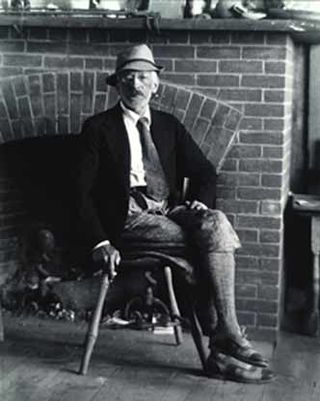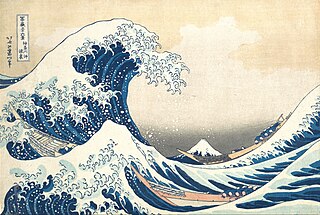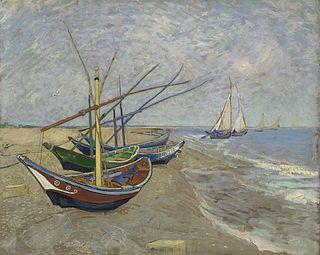
John Singer Sargent was an American expatriate artist, considered the "leading portrait painter of his generation" for his evocations of Edwardian-era luxury. He created roughly 900 oil paintings and more than 2,000 watercolors, as well as countless sketches and charcoal drawings. His oeuvre documents worldwide travel, from Venice to the Tyrol, Corfu, Spain, the Middle East, Montana, Maine, and Florida.

Winslow Homer was an American landscape painter and illustrator, best known for his marine subjects. He is considered one of the foremost painters in 19th-century America and a preeminent figure in American art.

Johan Barthold Jongkind was a Dutch painter and printmaker. He painted marine landscapes in a free manner and is regarded as a forerunner of Impressionism.

Charles Herbert Woodbury, was an American marine painter.

Frank Weston Benson, frequently referred to as Frank W. Benson, was an American artist from Salem, Massachusetts known for his Realistic portraits, American Impressionist paintings, watercolors and etchings. He began his career painting portraits of distinguished families and murals for the Library of Congress. Some of his best known paintings depict his daughters outdoors at Benson's summer home, Wooster Farm, on the island of North Haven, Maine. He also produced numerous oil, wash and watercolor paintings and etchings of wildfowl and landscapes.

Louis Choris (1795–1828) was a German-Russian painter and explorer. He was one of the first sketch artists for expedition research.

The Gulf Stream is an 1899 oil painting by Winslow Homer. It shows a man in a small dismasted rudderless fishing boat struggling against the waves of the sea, and was the artist's statement on a theme that had interested him for more than a decade. Homer vacationed often in Florida, Cuba, and the Caribbean.

Adolf Dehn was an American artist known mainly as a lithographer. Throughout his artistic career, he participated in and helped define some important movements in American art, including regionalism, social realism, and caricature. A two-time recipient of the Guggenheim Fellowship, he was known for both his technical skills and his high-spirited, droll depictions of human foibles.

The Great Wave off Kanagawa is a woodblock print by Japanese ukiyo-e artist Hokusai, created in late 1831 during the Edo period of Japanese history. The print depicts three boats moving through a storm-tossed sea, with a large wave forming a spiral in the centre and Mount Fuji visible in the background.

A fishing village is a village, usually located near a fishing ground, with an economy based on catching fish and harvesting seafood. The continents and islands around the world have coastlines totalling around 356,000 kilometres (221,000 mi). From Neolithic times, these coastlines, as well as the shorelines of inland lakes and the banks of rivers, have been punctuated with fishing villages. Most surviving fishing villages are traditional.

Thomas Pollock Anshutz was an American painter and teacher. Known for his portraiture and genre scenes, Anshutz was a co-founder of The Darby School. One of Thomas Eakins's most prominent students, he succeeded Eakins as director of drawing and painting classes at the Pennsylvania Academy of Fine Arts.
Puckaster is a hamlet on the Isle of Wight, England. Puckaster is on the southern coast of the Isle of Wight, south of Niton, between St. Catherine's Point and Binnel.
Jack Lorimer Gray was a Canadian artist, known particularly for marine art.

The Brighton Fishing Museum is a registered independent museum established in co-operation with the local fishing community in 1994. This museum is dedicated to Brighton's fishing and seaside history. It is located a short distance to the west of Brighton Pier within an area known as the Fishing Quarter, occupying two of the arches on the Kings' Road, which runs along Brighton's beachfront. Admission is free and donations appreciated.

The Boat Builders is an oil painting on panel by American landscape painter Winslow Homer, which is held in the collection of the Indianapolis Museum of Art (IMA), in Indianapolis, Indiana, United States.

The early works of Vincent van Gogh comprise a group of paintings and drawings that Vincent van Gogh made when he was 27 and 28, in 1881 and 1882, his first two years of serious artistic exploration. Over the course of the two-year period Van Gogh lived in several places. He left Brussels, where he had studied for about a year in 1881, to return to his parents’ home in Etten, where he made studies of some of the residents of the town. In January 1882 Van Gogh went to The Hague where he studied with his cousin-in-law Anton Mauve and set up a studio, funded by Mauve. During the ten years of Van Gogh's artistic career from 1881 to 1890 Vincent's brother Theo would be a continuing source of inspiration and financial support; his first financial support began in 1880 funding Vincent while he lived in Brussels.

Saintes-Maries is the subject of a series of paintings that Vincent van Gogh made in 1888. When Van Gogh lived in Arles, he took a trip to Saintes-Maries-de-la-Mer on the Mediterranean Sea, where he made several paintings of the seascape and town.

The Navicella or Bark of St. Peter, of Old Saint Peter's Basilica in Rome, was a large and famous mosaic by Giotto di Bondone that occupied a large part of the wall above the entrance arcade, facing the main facade of the basilica across the courtyard. It depicted the version from the Gospel of Matthew of Christ walking on the water, the only one of the three gospel accounts where Saint Peter is summoned to join him. It was almost entirely destroyed during the construction of the new Saint Peter's Basilica in the 17th century, but fragments were preserved from the sides of the composition, and what is effectively a new work, incorporating some original fragments, was restored to a position at the centre of the portico of the new building in 1675.

The Fog Warning is one of several paintings on marine subjects by the late-19th-century American painter Winslow Homer (1836–1910). Together with The Herring Net and Breezing Up, painted the same year and also depicting the hard lives of fishermen in Maine, it is considered among his best works on such topics.
Florian Kenneth Lawton was an American visual artist and a realist painter who worked primarily in a regional style.

















